2016 MXA RACE TEST: EVERYTHING YOU NEED TO KNOW ABOUT THE KTM 450SXF
Q: FIRST AND FOREMOST, IS THE 2016 KTM 450SXF BETTER THAN THE 2015 450SXF?
A: Yes. It is much better than the 2015 KTM 450SXF and significantly improved over the 2015-1/2 Factory Edition IV version
Q: WHAT DID KTM CHANGE BETWEEN THE 2015 MODEL AND THE 2016 MODEL?
A: Both bikes have black rubber tires; other than that, the 2016 model shares almost nothing with the 2015 450SXF.
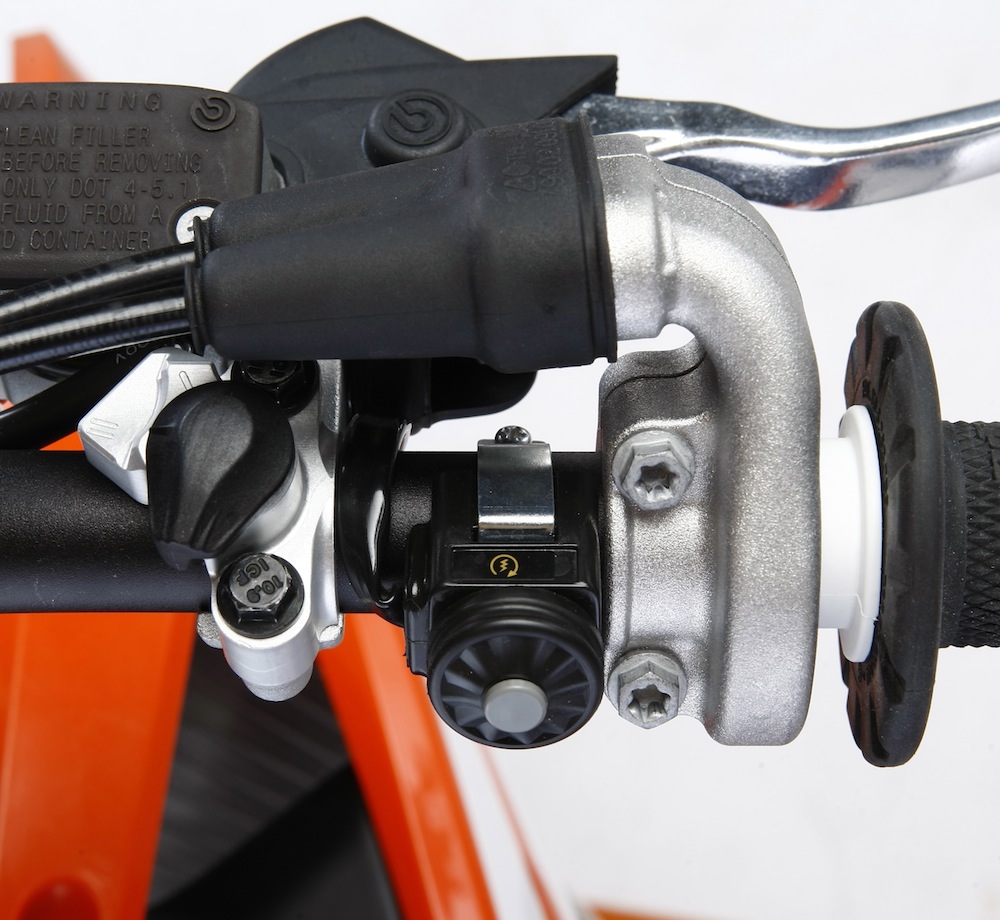 Magic buttons: The button on the right is the starter, while the switch on the left is the map switch and launch control combined.
Magic buttons: The button on the right is the starter, while the switch on the left is the map switch and launch control combined.
Q: WHAT DID KTM CHANGE BETWEEN THE 2015-1/2 FACTORY EDITION AND THE 2016 MODEL?
A: This question makes more sense. It cuts straight to the heart of what KTM learned from the early-release Factory Edition IV and how they applied it to the 2016 production bike. Here is a list of the differences between the 2016 450SXF and the five-month-older Factory Edition.
(1) 4CS forks. The WP 4CS forks were re-valved to make them softer. Many Factory Edition riders complained that they had to turn the compression clicker all the way out to make the forks absorb bumps. So, WP changed the shim stack to provide a plusher feel.
(2) WP shock. The mid- and high-speed damping was reduced to soften the overall feel through the whole valve stack. The goal was to eliminate the stagey feel of the Factory Edition shock.
(3) Radiators. In the past KTM had three different radiators for its range of bikes. The 2016 KTM 450SXF will use the same left radiator as all the other bikes, differentiated by a spigot change, but the 450SXF still has its own proprietary right radiator. Additionally, the black plastic radiator guards have been redesigned to allow roost and dirt to escape, while being strong enough to act as radiator braces.
(4) Chain guide. The rear chain guide has been lengthened to help guide the chain onto the sprocket teeth more effectively.
(5) Frame color. The frame is now powdercoated black in a move that makes very few KTM owners or buyers happy. Most KTM owners lusted after the orange frames that the works bikes used for a decade. Now, after one year, the orange RAL2009 powdercoating is gone. Boo. Obviously, the graphics have been changed since the Factory Edition IV, but mostly the aesthetics just come down to the removal of the Red Bull logos and some slight color shifts. The acronyms “KTM” and “SX” are obscurely printed into the right and left radiator wing designs. You might never notice it, but the gas tank is actually different on the 2016 model than on the Factory Edition, but just to support the radiator shrouds better.
(6) Rear brake-pedal spring. A stiffer and stronger ovalized brake-pedal spring replaces last year’s weaker round spring. But, it does have one problem, which you will find later in this test.
(7) Brake rotors. The Galfer Wave brake rotors are lighter by approximately 1-1/2 ounces (front and rear). They have a new vent pattern, and, if you look closely, you can see the magnet fitting for the odometer on the offroad models.
(8) Wheels. The Factory Edition had silver spokes, but the 2016 model has black spokes. In previous years KTM used a special coating process to make the spokes black. They have now determined that the original coating process was not good for the durability of the spoke’s metal and have switched to powdercoating the spokes black for 2016.
(9) Throttle housing. Although this was a mid-model change on some Factory Editions, all the 2016 KTM 450SXF’s will come with raw silver throttle housings instead of black.
(10) Mapping. The 2016 KTM 450SXF gets a different map than the 2015-1/2 Factory Edition. Not only does it improve starting, but delivers more fuel down low and a better transition from low to mid.
Q: HOW GOOD ARE THE 2016 4CS FORKS?
A: Let’s cut to the chase. The most important aspect of any KTM is its forks. Over the years the WP suspension has been the weak link in KTM’s almost flawless overall design. It doesn’t matter how well a KTM handles, how fast it is, how easy it starts or how great the brakes are if the forks beat you to death. Thus, the question of how good the 2016 WP forks are is of paramount importance.
So, how good are they? They are better than the 2015 forks and better than the Factory Edition forks. They aren’t the best forks on the track, but they are better set-up for the majority of KTM riders than several Japanese forks. The MXA wrecking crew was in full agreement that the 2016 WP forks are plusher and more resilient in the bumps, especially the small choppy stuff that used to be the Achilles heel of WP’s suspension setup. But, that is where the agreement ends. The faster MXA test riders thought that KTM went too far in making its forks work better for the vast majority of KTM owners, who tend to be older and more sedate. They felt that the forks dove too much in the first part of the travel and were prone to bottoming.
As for the riders that KTM aimed their damping for, they felt that the new forks were light years better than last year’s forks, with the caveat that they were too quick in the first half of the travel. The consensus was that the overall feel was acceptable for a production bike. This was the first time in a long time that MXA’s Vet test riders could actually turned the compression clicker in both direction and get an improvement. In the past they have broken the clicker trying to turn it all the way out.
Choosing fork valving in modern times is a delicate balance between jump tracks versus natural-terrain tracks, fast Pros versus steady Vets, and bottoming resistance versus suppleness. In our opinion, we think that KTM made the right choice in selecting comfort over stiffness. And while the WP valving may not make high-flying Pros happy, we don’t know any Pros who run stock suspension, even on their Yamahas.
Would we prefer to have Yamaha SSS forks on our 2016 KTM 450SXF? Yes, we would, but we would also prefer to have Yamaha SSS forks on our KX450F, RM-Z450, CRF450 and anything else with two wheels.
Q: WHAT ABOUT THE REAR SHOCK?
A: The relationship between the forks and the shock is a tangled web of mysterious forces. The simple explanation, without a lot of techno mumbo-jumbo, is that when the forks don’t work, the shock can’t work. Past WP forks were too soft initially and way too harsh at the end of the stroke. When the fork travel came to a screeching halt against WP’s wall of damping, the excess forces would rotate through the axis of the frame and make the shock kick. Had last year’s WP forks absorbed more energy, the shock wouldn’t have had to deal with the double whammy of conflicting actions and reactions.
And that is what is so much better about the 2016 model. Since the forks are plusher and move deeper into their stroke before trying to erase the downward motion, the shock is under less load—and the result is that the rear end is a big improvement over previous KTMs. Yes, KTM did re-valve the shock to work better, but in truth, re-valving the forks is what improved the shock.
In the end we aren’t big fans of KTM’s spring rate choice on the 2016 KTM 450SXF shock. We think that it is too stiff for anyone under 190 pounds. If that’s you, consider switching to a lighter spring
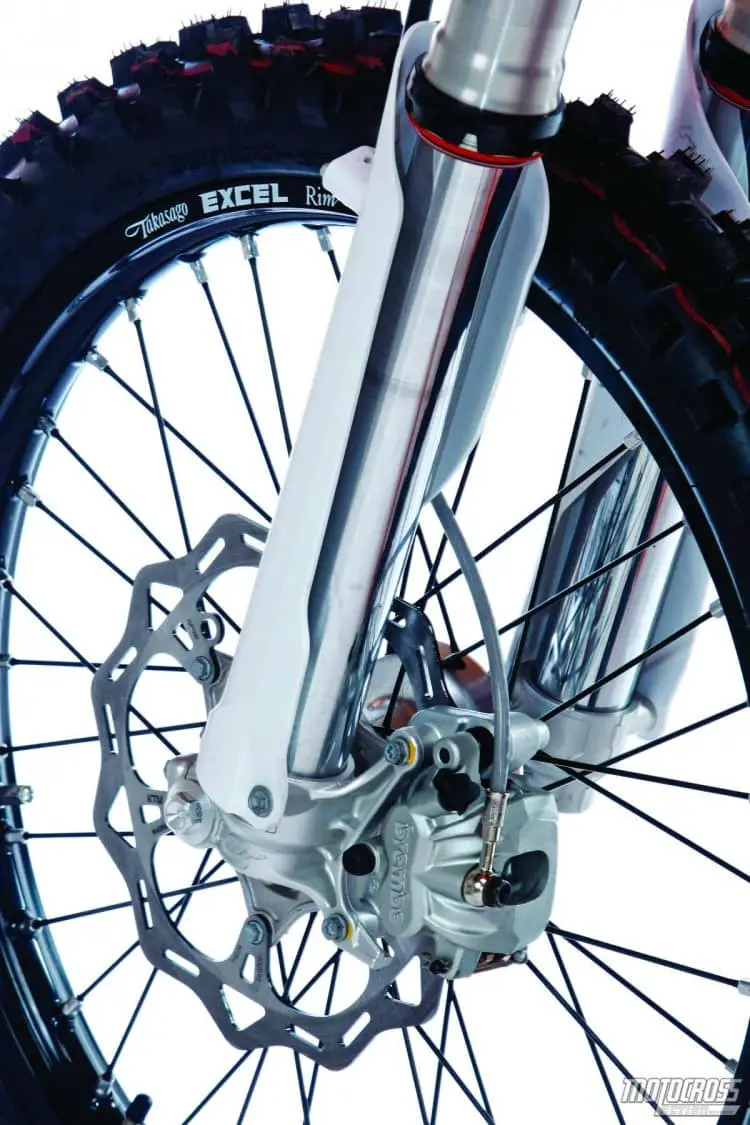 Pucker up: KTM has forced every manufacturer, except Suzuki, to up their brake game for 2016. That’s a side effect of KTM’s effort. Electric starters, hydraulic clutches, foolproof air filters, bulletproof clutches and major weight savings will be required for the Big Four to keep up with KTM.
Pucker up: KTM has forced every manufacturer, except Suzuki, to up their brake game for 2016. That’s a side effect of KTM’s effort. Electric starters, hydraulic clutches, foolproof air filters, bulletproof clutches and major weight savings will be required for the Big Four to keep up with KTM.
Q: HOW FAST IS THE 2016 KTM 450SXF?
A: If you are from the school of thought that 450cc motocross bikes are too powerful for mortal man, you are about to have your psyche realigned. While Honda has promoted the idea that the only way to make a 450cc motocross bike manageable is to make it slow, KTM blows that idea out of the waters with a very powerful engine that is super easy to ride. In fact, with five more horsepower than the CRF450, the KTM is actually more pleasant than the CRF450 at throttle tip-in. It can be ridden through corners at quarter throttle, half throttle or full throttle without breaking loose or creating sweaty palms. There is a power setting for every kind of track situation — from slick off-cambers to loose sand to deep loam. Then, when the time comes to cover ground quickly, all you have to do is touch the clutch or twist your wrist and it switches from rheostat to rampaging bull.
The pleasant low-to-mid transition becomes stronger as the rpm increases — and when you need max power, you’ve got it in reserve. No bike on the showroom floors today makes as much low-end, midrange, top-end or peak horsepower as the 2016 KTM 450SXF—that’s an endorsement of the power output. Best of all, the 2016 KTM 450SXF powerband pulls forever. In fact, half of the MXA test riders thought that the powerband was a little too manageable. They wanted more of a thrill ride, not just for the adrenaline rush, but to get the KTM up on the pipe and churning quicker. Our Pro test riders added one tooth to the rear sprocket to liven up the hit.
Q: HOW DOES THE 2016 KTM 450SXF RUN ON THE DYNO?
A: We know that KTM claims that the 2016 450SXF makes over 60 horsepower, and we don’t disbelieve them. But on our dyno (the same one we have used for every test bike for the last 10 years), it made a hair under 58 horsepower (57.98 to be exact). Why don’t we think they are lying if our dyno reading was less? Every dyno is different, and, as a rule of thumb, the only comparisons that can be made about an engine are by running it on the same dyno. On our dyno it made 58 horsepower. We think that when the engine loosens up after a few hours we will get 59 out of it.
Stats are not the be-all, end-all of motocross engines, but the KTM’s 58 horsepower is a solid number (and the most of any 2016 production 450) and when combined with its 36.5 foot-pounds of torque, you’ll never have to worry about some bully kicking sand in your face at the beach.
Q: HOW DOES THE 2016 KTM 450SXF RUN ON THE TRACK?
A: Thanks to new ECU changes, the 2016 KTM jumps to life quickly. It starts with less drag on the battery and runs cleaner. We always felt that our 2015-1/2 Factory Edition had a flat spot in the powerband and a “lean pop” when it took a breath before taking off in the midrange. Not so with the 2016 engine. It is smooth as silk. The 2016 KTM 450SXF comes with Launch Control, but it is convoluted to work with. It works, but you need to read the owner’s manual to decipher all of its ins-and-out. KTM sent a bulletin out to 2016 buyers to help explain it better. It is worth noting that Ryan Dungey’s KTM 450SXF does not have Launch Control installed.
With a powerband that pulls longer than any other engine on the track, you can come out of the gate in second and let the bike rev in one gear while the green, yellow and red bikes are shifting (the blue bike makes its best power high in the range). Once at speed, the power is still manageable. It’s not white-knuckle scary, but if the brakes weren’t so great, everything from your eyeballs to your toes would pucker up as you rocketed into turns. This is a different kind of power. It doesn’t blast megawatts as much as it oozes them. You can use as much as you want, or as little as you need.
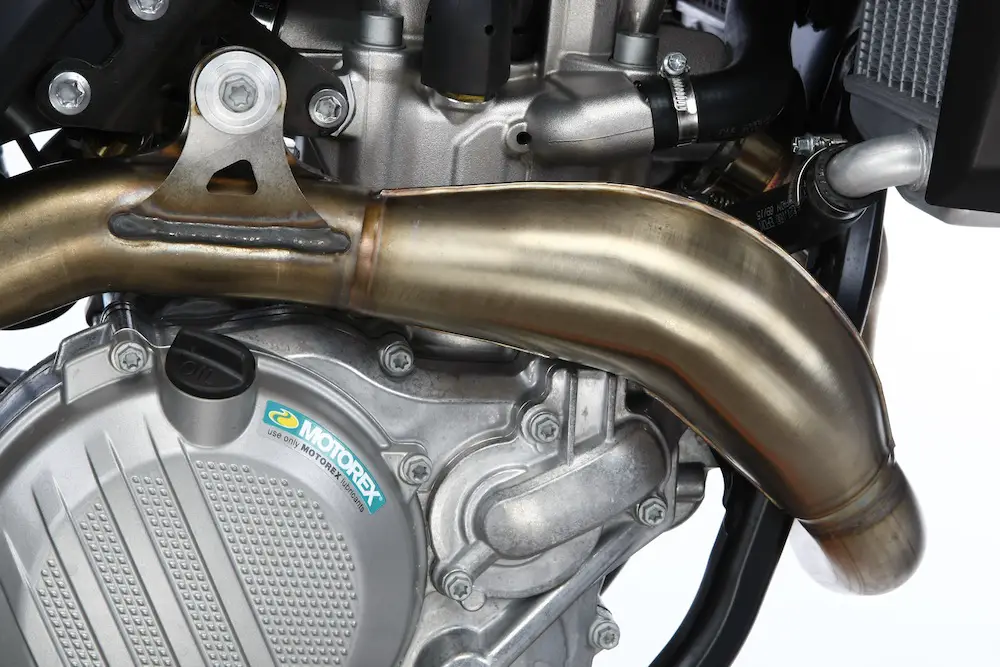 The dome: Although it looks like a two-stroke pipe, the stamped pieces are KTM’s resonance chamber.
The dome: Although it looks like a two-stroke pipe, the stamped pieces are KTM’s resonance chamber.
Q: HOW DOES THE 2015 KTM 450SXF HANDLE?
A: The MXA wrecking crew loves the neutral handling of KTM’s chromoly steel chassis. It is the best all-around-handling bike on the track. It handles instinctively. You just have to think about choosing a line and it takes it. There is one caveat — you have to fiddle with the fork leg height to dial it in to perfection. One millimeter in either direction can make a noticeable difference, and it’s not unusual for an MXA test rider to come in from a race and slide his forks down to change the cornering habits for the next moto.
Q: WHAT’S THE BEST PART OF THE 2016 KTM 450SXF?
A: Don’t be silly. It weighs 227 pounds. We are talking about the lightest 450 bike on the track — and it meets that weight limit with a battery and electric starter. It has awesome brakes, a bulletproof hydraulic clutch, flawless shifting, an air filter that plugs into the airbox (without tools), a marine-grade wiring harness, quick-release fuel lines, Dunlop MX32 tires, black Excel rims, in-line fuel filters, rubber-mounted bars, plastic frame guards, direct-connect throttle cables, in-mold graphics and a legal AMA muffler.
 What don’t we like about this brake pedal spring. Read #8 on the Hate List to find out.
What don’t we like about this brake pedal spring. Read #8 on the Hate List to find out.
Q: WHAT DID WE HATE?
A: The hate list:
(1) Frame color. We didn’t beg, plead and cajole for an orange frame for a decade just to have it taken away so that the black plastic frame guards would match it.
(2) Black plastic frame guards. Some test riders complained that their boots caught on the edge of them, while others think that the guards moved their feet out too far. We removed them and replaced them with either Nihilo frame tape or nothing (except a can of touch-up paint).
(3) Gas cap. It sticks. Take a body-building class; you’ll need it at some point.
(4) Pipe. You can’t take the pipe off the bike without removing the shock—and removing the shock is a pain.
(5) Sprocket bolts. Watch them and the spoke next to the rear rim lock like a hawk or they will fly away.
(6) Neutral. We love how well the KTM shifts from gear to gear, but hate how hard it is to get into neutral when the engine is running.
(7) Bike stand. When the bike is sitting on a bike stand, the front wheel is on the ground. This is a hassle when checking the spokes or working on the front end. Most stand companies made an add-on addition to deal with the slanted frame cradles on Yamaha two-strokes, as well as KTM and Honda.
(8) Brake pedal spring. Turn the brake pedal spring around so that the tang that goes through the top of the brake pedal in facing inward. We were able to accidentally push the spring off the brake pedal when the tang faced outwards,. We also crimp the tangs so that fit tighter.
(9) Shifter tip spring. We broke the shifter tip springs on two of our test KTM’s—although not on our 450SXF. In a pinch we wrap the shift tip in duct tape to finish the day.
(10) Crossbar pad. It may sound picky, but we don’t like how the crossbar pad shifts back and forth on the handlebars.
(11) Fork clickers. Although you love the ability to change the compression rebound stetting on the WP forks without having to dig in the toolbox for a screwdriver, the cog-shaped clicker needs to have longer cogs so that the clicks can be made much quicker and easier.
 Profile: The engine is fast, but easy to ride.
Profile: The engine is fast, but easy to ride.
Q: WHAT DID WE LIKE?
A: The like list:
(1) Weight. We were impressed that the 2015 model was 1.3 pounds lighter than the 2014 KTM 450SXF. The 2016 bike is 7.9 pounds lighter than the 2015 model at 227 pounds. Only the Husqvarna FC450 is close at 229 pounds. The KX450F is third lightest at 231 pounds, while the Suzuki RM-Z450 weighs 13 pounds more at 240 pounds.
(2) Powerband. Easy-to-ride bikes don’t have to be slow. The 2016 KTM 450SXF proves it.
(3) Tires. Last year KTM spec’ed the 450SXF with Dunlop MX52 tires, which replaced the MX51s. For 2016 the 450SXF gets Dunlop MX32 intermediate tires. We love these tires, but we race on Intermediate dirt. If we ride them on hard dirt, the knobs on the sides of the front tire with tear off. They will even tear off if your ride on a track with soft corners and hard exits.
(4) Radiator design. Every manufacturer should look at the thought that KTM’s engineers put into getting air to actually flow through their radiator cores.
(5) Clutch. Honda, Yamaha, Suzuki and Kawasaki took 10 years to catch up to KTM’s braking power. How long until they build a self-adjusting, long-lasting, reliable hydraulic clutch.
(6) Electric start. Your great grandpa used to hand crank his car to get it started back in 1914.
(7) Handling. Once you balance the front and rear, you can go anywhere and do anything…without trying. Part of the KTM 450’s charm is its handling. Thanks to its 2016 diet, electric powerband and improved suspension, this bike can be steered with your knees.
(8) Air filter. The plug-and-play air filter is a very creative idea.
(9) Little things. This is not a BNG bike or an updated old design. It is new from the ground up. That shows — not just in the all-new engine, frame and plastic, but in the minor details that make a difference. The footpegs, shift lever, air filter, fuel lines, crossbar pad, chain guide,resonance chamber, CNC hubs and double-duty headstay/pipe mount all show that KTM cares.
Q: WHAT DO WE REALLY THINK?
A: This bike is awesome. Really awesome. In the past the forks have been the weak link, but for 2016 the forks are actually usable by their target audience (Vet riders with healthy bank accounts). If you think you are too fast for the stock forks, we know some excellent suspension gurus who can fix KTM 4CS forks for around $350. After all, you won’t be spending any cash on Hinson clutches, aftermarket exhaust pipes, oversize brake rotors or aftermarket wheels.
MXA’S 2016 KTM 450SXF SETUP SPECS
This is how we set our 2016 KTM 450SXF up for racing. We offer it as a guide to help you find your own sweet spot.
4CS FORK SETTINGS
These aren’t Supercross forks. Thankfully, they don’t feel like they are in a death match with your hands every time you hit a bump. They are more compliant than in the past and actually usable by the riders they were designed for. Do we think they are the best forks made? No. Do we think they are raceable in stock trim? Yes—although not for Supercross. For hard-core racing we recommend this fork setup on the 2016 KTM 450SXF (stock specs are in parentheses):
Spring rate: 0.48 N/m
Compression: 10 clicks out for Intermediates and 20 clicks out for Novices (15 clicks out)
Rebound: 15 clicks out
Fork leg height: 5mm up
Notes: The faster the test rider, the more they were able to bottom the forks. We added 10cc of oil to each leg to stiffen the second half of the stroke for them. If you are a slower rider and have the forks all the way out, consider lowering the oil in each leg by 10cc.
WP SHOCK SETTINGS
We have issues with the stock spring rate. It works best for rider over 190 pounds. If you weigh less you may have trouble getting any preload on the shock spring. In that case, switch to a softer spring (we used the 45 N/m spring off of the 250SXF). KTM actually embossed a sag scale line on the rear fender to make sure that riders measure their race sag in the right place. WP recommends 110mm of sag, but don’t be foolish. That is too low. Set the sag at 105mm. For hard-core racing we recommend this shock setup for the 2016 KTM 450SXF (stock specs are in parentheses):
Spring rate: 45 N/m (48 N/m)
Race sag: 105mm
Hi-compression: 1-3/4 turns out (2 turns out)
Lo-compression: 15 clicks out
Rebound: 12 clicks out (15 clicks out)
Notes: We turned the high-speed compression damping in a little to lessen G-outs, and ran a touch more rebound than the recommended setting. Additionally, we set the sag at 105mm (not the recommend 110 mm.
MXA’S 2016 KTM 450SXF VIDEO



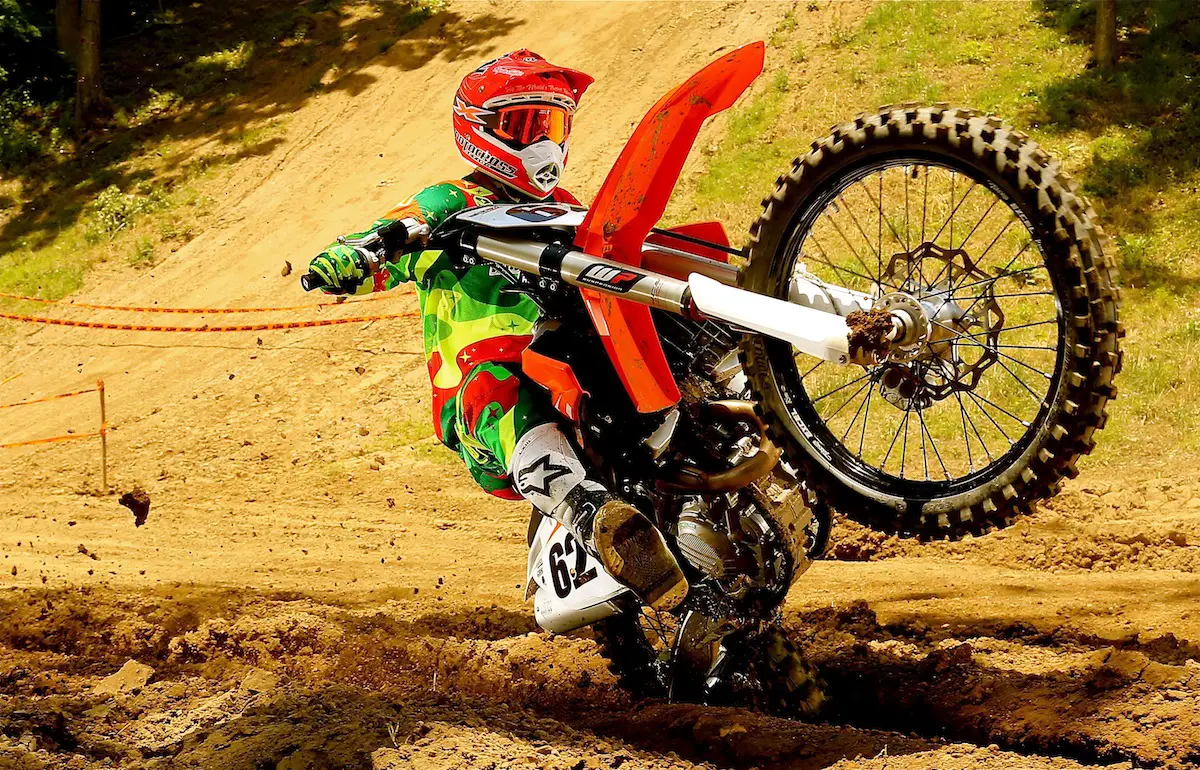
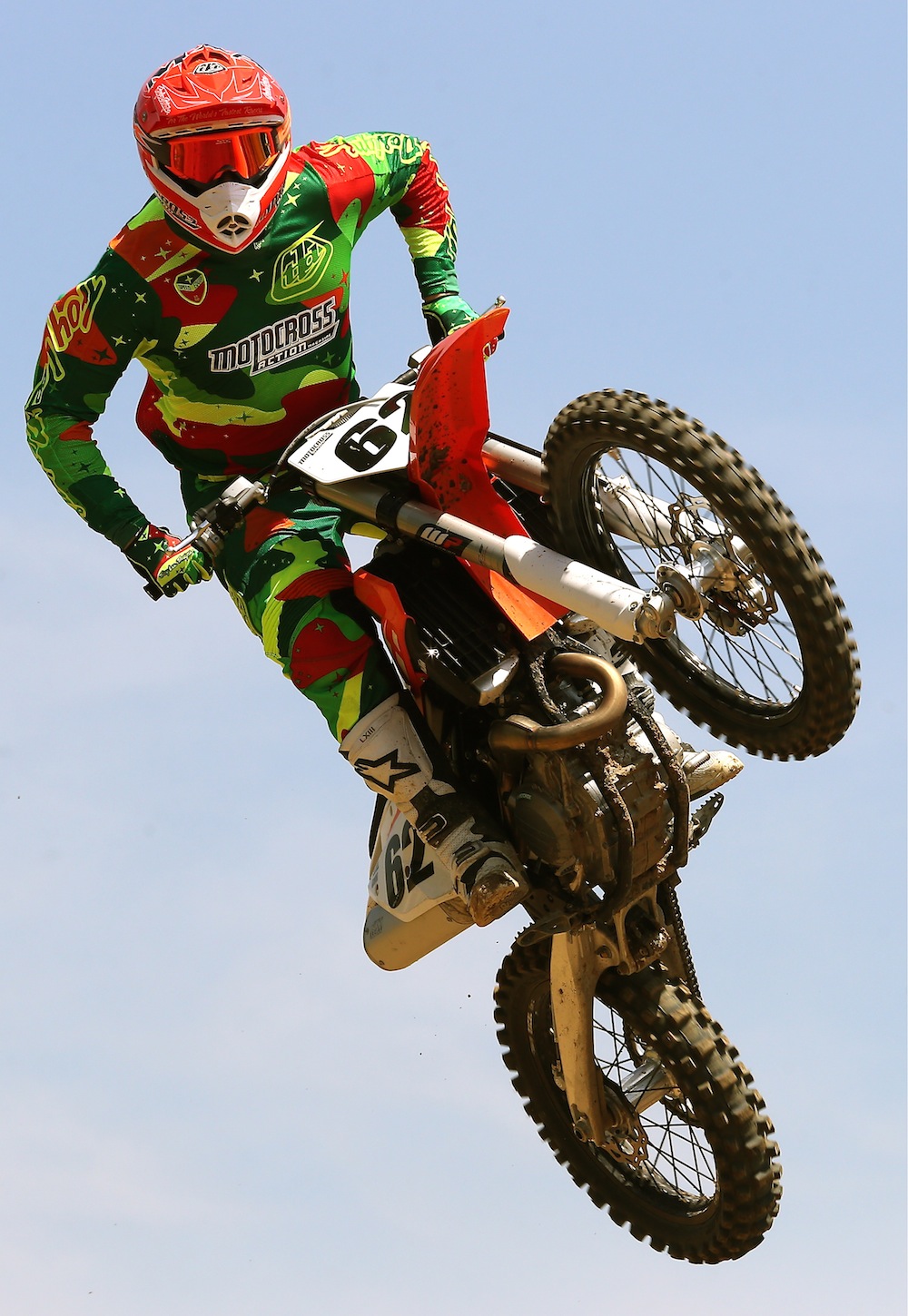
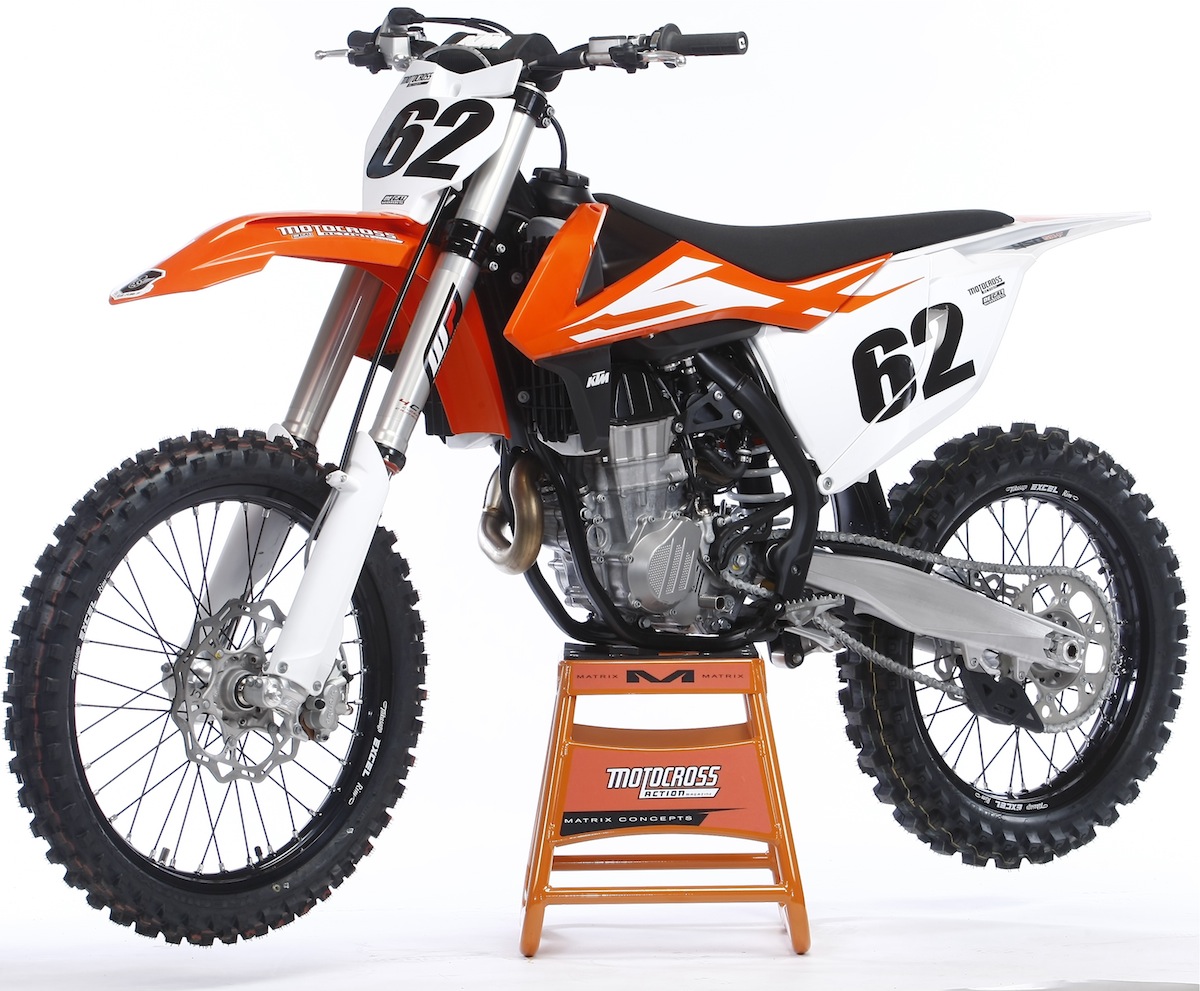
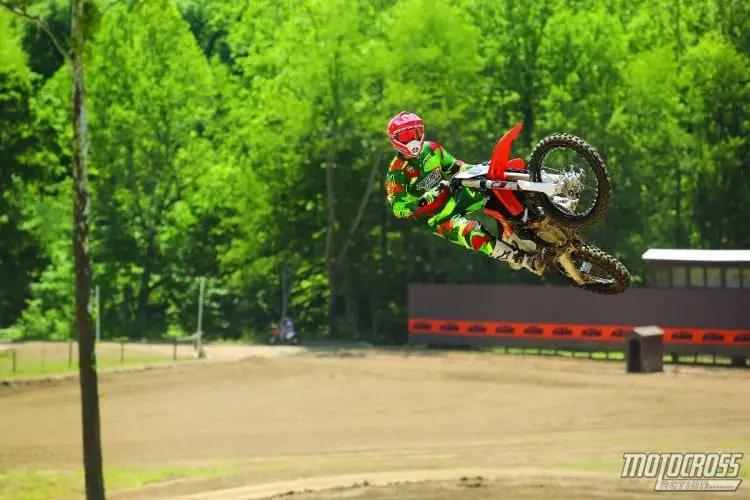


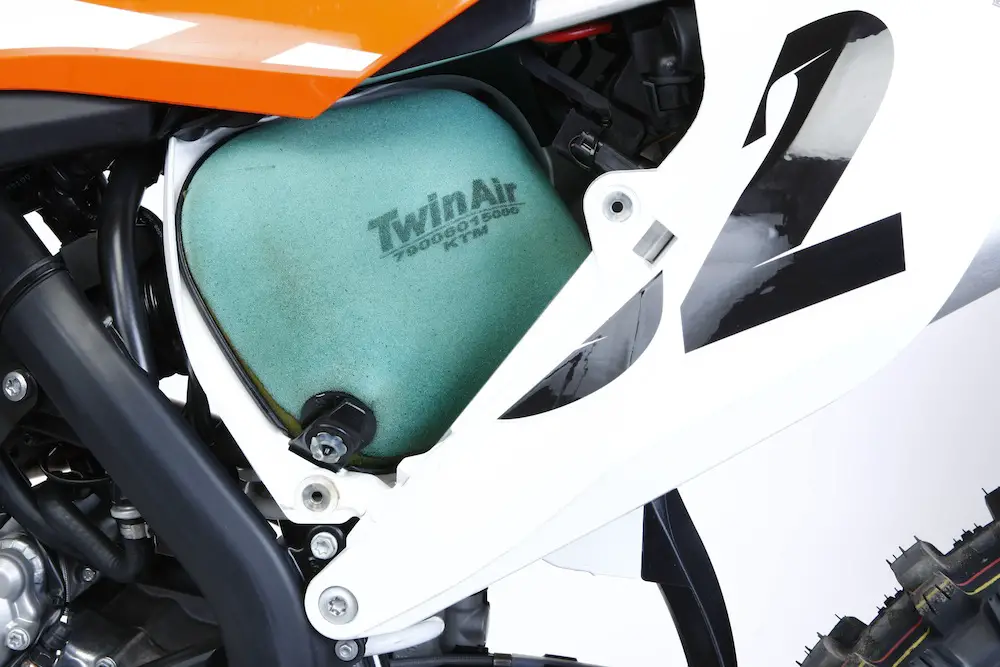
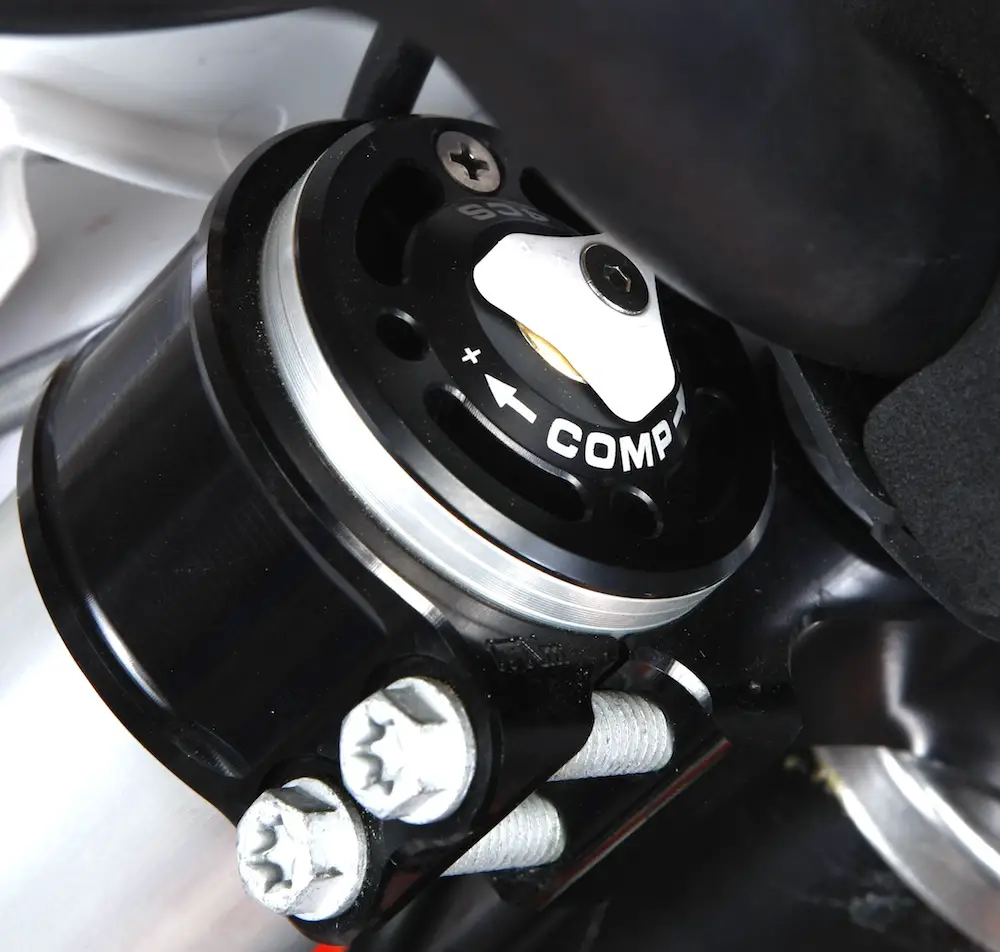


Comments are closed.